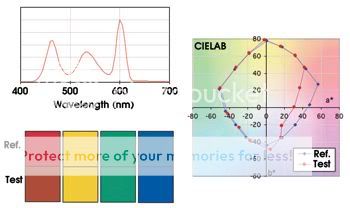Brian321
Enlightened
I am just wondering the difference between the two? Like how much brighter is a cool tint over a warm tint(same flashlight/ Lumen rating)? Thanks.
Also which would be better for caving?
Also which would be better for caving?
 Help Support Candle Power Flashlight Forum
Help Support Candle Power Flashlight Forum
That's a bit like asking which is heavier - a pound of nails or a pound of feathers. Lumens are how overall brightness is usually measured, so two identical lights with the same lumen rating should appear equally bright. The warmer tint LEDs are generally available in slightly lower output ratings than cool tints though, so typically the warm variant of a given light will have a slightly lower lumen rating than the cool version. This is simply a function of the phosphor having to convert more of the blue light to longer wavelengths.Like how much brighter is a cool tint over a warm tint(same flashlight/ Lumen rating)?

Oh no, not again...
I honestly didn't know this was a big controversy. To me it's a simple trade off. A few lumens for a nice tint. Are people arguing about the usefulness of the neutral light in actual use? Has anyone done any real testing to see if:
A. Color rendition matters
B. If yes to A, do the neutral LEDs emulate a true incan enough?
I hope I don't aid in the horse beating . . . I never participated in the other threads. I never even noticed them!
so two identical lights with the same lumen rating should appear equally bright.
Lumens are already weighted to take this into account:But visual sensitivity is not equal across the EMR spectrum. Our vision is most sensitive at 550nm (yellow-green)/
http://en.wikipedia.org/wiki/Lumen_%28unit%29The lumen (symbol: lm) is the SI unit of luminous flux, a measure of the power of light perceived by the human eye. Luminous flux differs from radiant flux, the measure of the total power of light emitted, in that luminous flux is adjusted to reflect the varying sensitivity of the human eye to different wavelengths of light.
Lumens are already weighted to take this into account:
http://en.wikipedia.org/wiki/Lumen_(unit)
I'm not quite sure what you are asking now.
The original question was which of two lights with the same lumens would appear brighter. Since lumens are a measure of perceived brightness then pretty much by definition the only sensible answer is that they would appear equally bright.
I am just wondering the difference between the two? Like how much brighter is a cool tint over a warm tint(same flashlight/ Lumen rating)? Thanks.
Also which would be better for caving?
I have always found colder tints brighter "looking"
As opposed to warm tints, and see smaller details.


